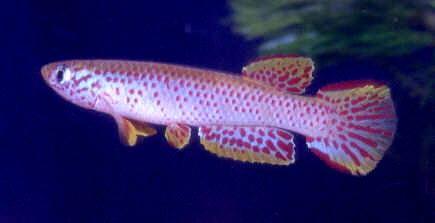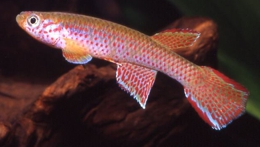|
Originally described by Boulenger in 1915 from
10 specimens (collected by C.Christy) as Haplochilus
christyi in the Lindi River which drains into the
Zaire River a few kms west of Kisangani. These type specimens are deposited
in the Museum of Central Africa, Tervuren, Belgium and are labelled
'Bafwasende', a location some 200-250 kms northeast of Kisangani.
In 1924 Myers described a new sp. caught at Stanleyville (Kisangani)
& Medje in the northern Congo basin as Aphyosemion
castaneum which he used
as the holotype for the Genus Aphyosemion.
Boulenger
gives the following collector / location in his 1915 Catalogue.
- 1-10 (Types). Collected in the Lindi River by Dr.C.Christy.
Hoedeman reports them being imported into Belgium
in 1947 & 1948. These were imported under the name Aphyosemion
singa.
Scheel in ROTOW 1 refers to their being kept
as aquarium fish since 1949. These first imports were said to have originated
from Leopoldville & had few spots on sides.
In 1930 Pellegrin found the same fish at Liboumbi
but it was not until 1952 that Poll gave the fish its present name of
A.christyi.
Haplochilus christyi & A.christyi
were found at the same location in the Lindi River (sometimes
quoted in literature as Lundi) drainage near Stanleyville (Kisangani).
They were first reportedly imported to Belgium in 1951 from Leopoldville.
P.Depasse collected 5 specimens in the Epulu River at Camp Putnam
In the UK the first documented import I can find
dates back to the summer of 1938 where Fred Wright (a previous BKA Technical
Editor) received a pair which had come from Germany that year. (BKA
newsletter No.66, February 1971). These were reportedly identical to
the 'cognatum' being distributed
in 1971. This newsletter contains a b/w photo by Roloff of 'A.schoutedeni'.
In 1949 Aquarium Hamburg received a shipment
containing this sp. which were identified as 'Aphyosemion
singa'. Several years later another import was received which
had fewer red spots on the fins & body. This was considered a yellow
variation. Basic outlines of these fish with descriptions can be found
in the Aquarium Journal April 1962 in an article by Bruce Turner &
Albert Klee.
First importation into the
USA was in the early 1950's. Known to be in
the BKA in December 1966 when fish were sent from Australia. No population was
given but it was described as being 'a striking little fish, body reflecting blue
with a lined pattern of chestnut brown, made up of rows of spots, yellow fins
edged at times with a bold pattern of these spots again' (BKA newsletter No.16,
December 1966.
The BKA had an import described as christyi
in October 1974 from Kinshasa. These were said to resemble the photo
on page 157 of ROTOW
1.
Geoff Wood caught A.christyi
in the 1970's at Kinsuka although these fish were distributed as Kinshasa.
The true location was 13 km downstream from Kinshasa & about 1 km
from the river. These were reportedly very colourful being blue/green
in colouration. Later generations seemed to lose the original colouration.
This population was only found in one small location. Red markings were
found to be variable.
In 1986 T.Roberts & L.de Vos collected an
Aphyosemion sp. near the Epulu
River ferry.
The Kinshasa population was originally brought
to the UK by Geoff Wood but has since disappeared. Now & again A.christyi
Kinshasa is distributed from commercial imports. The collection point
should be taken with a 'pinch of salt' as there is no guarantee as to
where they were caught. Kinshasa is the airport of departure used for
these fish. The photo below of 'Wild Import 1998' was such a collection.
These collections show a large blue/purple area between the eye &
mid body section.
Emmanuel Vreven made collections in the Okapi
Faunal Reserve.
History of the synonym
A.schoutedeni
(Boulenger
1920)
Boulenger described this
sp. in 1920 from material collected from the Medje River which is an
affluent of the Ituri River, northeast Congo.
In 1952 Poll reported that this sp. was known from the Central Congo
drainage and 'individuals from the Leopoldville area had very few red
spots on the sides, compared to other local populations in the Congo'
(ROTOW 1 p 374).
He also mentions that this sp. was imported into Germany & had been
distributed as E.singa.
Poll, also in 1952 reported the sp. from Buta, Bambesa, Ibembo, Kunugu,
Lisala, Monga, Mongende, Stanleyville & Yangambi. These localities
fall into the north-northeastern area of the Central Congo (Zaire) drainage.
In 1959 Poll reported them from Leopoldville. Lambert, in 1961 considered
the sp. to represent a synonym of A.christyi
& commented that A.christyi
was a phenotype having 'very many red spots' whereas the A.schoutedeni
phenotype had 'very few such spots' (ROTOW
1 p 374).
A population from Leopoldville was imported as an aquarium fish in 1949
& distributed as E.singa. These
produced a stable aquarium strain. Scheel maintained this form &
commented that they bred true except for the yellow colouration in the
un-paired fins (anal fin in particular) which was absent in some males
of younger generations.
Their is some controversy regarding which sp. A.schoutedeni
should be a synonym of. Some authors prefer to place it as a synonym
of A.decorsei.
History of the synonym
A.margaretae
Fowler 1936
Collected in 1934 on the
George Vanderbilt expedition to Africa.
Described by Fowler in 1936 from 2 specimens collected near Saidi's
Village, Irumu - Avakubi road some 10 miles west of the Epulu River
ferry in the Kibali - Ituri districts, former Belgian Congo. This location
was 2800 feet above sea level. This location was a clearing in dense
& very tall rain forest. There were also other clearings in the
area which were starting to revert back to forest with young tree growth.
This primeval forest was said to reach 200 feet high ( 3 - 16th September
1934).
Meristics given in the original description were D=9-10, A=13-14, ll=25-26
(+3).
A line drawing can be found in
Scheel's ROTOW 1
page 292.
Poll, in 1952, considered the
described specimens to be juveniles or females, & preferred to put
them closer to ferranti.
Lambert mentions the populations from Yangambi & Ibembo to have
red stripes running horizontally similar to A.lujae.
Lambert in 1961 also found a population at Nyangwe, southeast Zaire.
Huber & Scheel considered them to be A.christyi
after examining the type material.
| 



